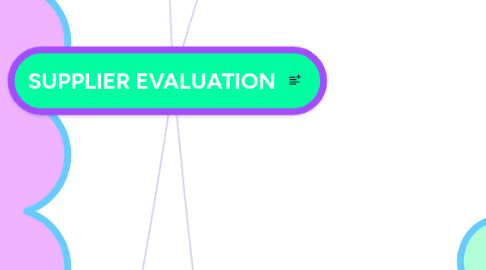
1. QUESTIONNAIRES AND SURVEY
1.1. Considering
1.1.1. SAMPLING TECHNIQUE
1.1.1.1. Phone calls
1.1.1.2. Emails
1.1.2. STUDY POPULATION
1.1.2.1. Group of individual
1.1.3. THE UNIT
1.1.3.1. Manufactoring
1.1.3.2. Transport
1.1.3.3. Retail company
1.1.4. VALIDITY AND RELIABILITY
1.1.4.1. Questionnaire
1.1.4.2. Test
1.1.4.3. Observation
1.1.4.4. Any measurement procedure
1.2. Data collected
1.2.1. PRIMARY DATA
1.2.1.1. Questionnaires
1.2.1.2. Emails
1.2.2. SECONDARY DATA
1.2.2.1. Online library
1.2.2.2. Textbooks
1.2.2.3. Google
1.2.2.4. other literature
2. GOALS
2.1. Increase perfomance visibility
2.2. Uncover and remove waste and cost drivers
2.3. Leverage the supply base
2.4. Align customer's and supplier's business practices
2.5. Mitigate risks
2.6. Improve supplier performance
3. APPROACHES
3.1. SCORECARD
3.1.1. QUALITY SYSTEM
3.1.1.1. Quality guarantee certification
3.1.1.2. Qualified rate of delivery
3.1.1.3. Quality process control
3.1.2. DELIVERY
3.1.2.1. The timeliness of delivery
3.1.2.2. Respond capable of order amount change
3.1.2.3. Elasticity of supply
3.1.2.4. Follow the customer plan
3.1.2.5. Duration of lead time
3.1.3. PRICE
3.1.3.1. Preferential price degree
3.1.3.2. The capacity to absorb the price
3.1.3.3. The space of cost reduces
3.1.4. TECHNICAL ABILITY
3.1.4.1. Product creativity
3.1.4.2. Process creativity
3.1.4.3. Development and research
3.1.5. FINANCIAL SITUATION
3.1.5.1. Profitability ratio
3.1.5.2. Debt ratio
3.1.5.3. Liquidity ratio
3.1.5.4. Operation ratio
3.2. SITE VISIT
3.2.1. ABILITY
3.2.1.1. Right production equipment and tools
3.2.1.2. Right test equipment and measurement instruments
3.2.1.3. Experience
3.2.1.4. Workers skills
3.2.2. CONSISTENCY
3.2.2.1. Clear and adapted production processes
3.2.2.2. Solid quality control processes
3.2.2.3. Systematic data collection and storage
3.2.3. MATURITY
3.2.3.1. A strong factory manager
3.2.3.2. A very experienced technician
3.2.3.3. A very dynamic sales person
3.2.4. FORMAL DOCUMENTS
3.2.4.1. Company business license
3.2.4.2. Company ISO 9001 certificate
3.2.4.3. Other company wide certificates
3.2.4.4. Export license
4. STRATEGY
4.1. SUPPLIERS SEGMENTATION
4.1.1. Kraljic Portfolio Purchasing Model
4.1.1.1. Strategic Items
4.1.1.1.1. High Risk High Impact
4.1.1.1.2. Positioning
4.1.1.2. Leverage Items
4.1.1.2.1. Low Risk High Impact
4.1.1.2.2. Positioning
4.1.1.3. Non Critical items
4.1.1.3.1. Low Risk Low Impact
4.1.1.3.2. Positioning
4.1.1.4. Bottleneck items
4.1.1.4.1. High Risk Low Impact
4.1.1.4.2. Positioning
4.1.2. Commitment Model
4.1.2.1. Low Commitment Low Actual Commitment
4.1.2.1.1. Maintain
4.1.2.2. Low Commitment High Actual Commitment
4.1.2.2.1. Caution
4.1.2.3. High Commitment High Actual Commitment
4.1.2.3.1. Maintain
4.1.2.4. High Commitment Low Actual Commitment
4.1.2.4.1. Plan for improvement
4.1.3. Design Product and Spend Model
4.1.3.1. Low Spend Low Design Input
4.1.3.1.1. Caution
4.1.3.2. Low Spend High Design Input
4.1.3.2.1. Target for redesign for standard item
4.1.3.3. High Spend Low Design Input
4.1.3.3.1. Maintain
4.1.3.4. High Spend High Design Input
4.1.3.4.1. Saving through Design Input
4.1.4. Risk and commitment Model
4.1.4.1. Low Commitment Low Risk
4.1.4.1.1. Transaction
4.1.4.2. Low Commitment High Risk
4.1.4.2.1. Special attention
4.1.4.3. High Commitment High Risk
4.1.4.3.1. Partnership
4.1.4.4. High Commitment Low Risk
4.1.4.4.1. Contract
4.2. ACTIONS FOR SEGMENTS
4.2.1. Management Action Matrix
4.2.1.1. Low cost of Ownership Low Dependence on Supplier
4.2.1.1.1. Commodity
4.2.1.2. High cost of Ownership Low Dependence on Supplier
4.2.1.2.1. Collaborative
4.2.1.3. Low cost of Ownership High Dependence on Supplier
4.2.1.3.1. Custom
4.2.1.4. High cost of Ownership High Dependence on Supplier
4.2.1.4.1. Strategic
4.2.2. Segmentation for performance action
4.2.2.1. Low cost of Ownership Low Dependence on Supplier
4.2.2.1.1. Commodity
4.2.2.2. High cost of Ownership Low Dependence on Supplier
4.2.2.2.1. Collaborative
4.2.2.3. Low cost of Ownership High Dependence on Supplier
4.2.2.3.1. Custom
4.2.2.4. High cost of Ownership High Dependence on Supplier
4.2.2.4.1. Strategic
4.3. EVALUATION STRATEGY
5. CRITERIA
5.1. COST
5.1.1. Internal factors
5.1.1.1. Logistics
5.1.1.2. Products types
5.1.1.3. Operations management
5.1.1.4. Technical ability
5.1.1.5. Pricing strategy
5.1.1.6. Quality
5.1.2. External factors
5.1.2.1. Economic
5.1.2.2. Political
5.1.2.3. Supplier relationship
5.1.2.4. Legislation
5.2. QUALITY
5.2.1. Poor
5.2.1.1. Administrative cost increase
5.2.1.2. Postpones delivery time
5.2.1.3. Remake production
5.2.2. High
5.2.2.1. Management responsibility
5.2.2.2. Defective rate
5.2.2.3. Process controlling
5.2.2.4. Security
5.2.2.5. Training
5.2.2.6. Standard equipment
5.2.2.7. Proactive
5.2.2.8. Inventory levels
5.2.2.9. Reliability
5.2.2.10. Customer service
5.3. TECHNOLOGY/INNOVATION
5.3.1. Innovative product
5.3.2. Explore new market
5.3.3. shortened cycle development.
5.3.4. Lower costs
5.3.5. High quality
5.4. TIME
5.4.1. Requirement
5.4.1.1. Kinds of material
5.4.1.2. Quantity
5.4.1.3. Weight
5.4.1.4. Size
5.4.1.5. Colour
5.4.1.6. Specific parameter of material
5.4.2. Lead time
5.4.2.1. Short lead time
5.4.2.2. Long lead time
5.4.3. Determination of required date
5.4.4. Exception feedback
